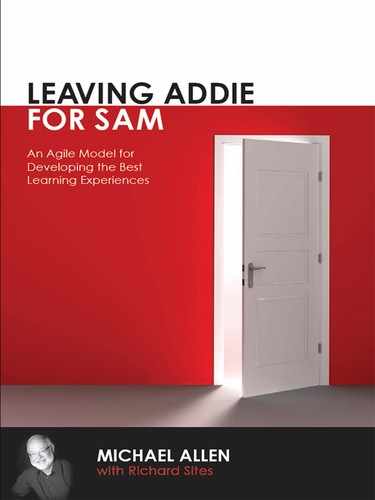CHAPTER 13
Additional Design
Unless the project is small or a small set of instructional designs covers all types and instances of content, the Savvy Start does not complete all the design work necessary. There are probably objectives not yet defined and written. The content has not yet been put in final sequence if in any sequence at all. Homework, projects, navigation, aids, and many other components may not have been given much attention.
COMPLETING THE DESIGN
It isn't the purpose of the Savvy Start to create all the content or even approach final form. Text, graphics, and other preparations have yet to be done, but this work is part of iterative development yet to come. At this point we look to finishing up the design work.
Iterations Continue
The process of additional design is not a new process. The same process used for the Savvy Start continues with iterations of design, prototyping, and evaluation.
Special-Purpose Prototypes
It is also in this phase of the process when special-purpose prototypes are created. These prototypes may take more time and effort than the Savvy Start permits (which is in part why they are not done then) and deal with issues that require special expertise.
Frequently needed special-purpose prototypes include:
- Look-and-feel—This type of prototype focuses on layout and style for print materials, projected materials, and electronic devices, including division of screen areas, color, text fonts, and effects such as drop shadows (additionally for e-learning, use of mouse gestures, touch input, etc.).
- Media—The media prototype demonstrates the use of photography, audio recordings, 3D illustration, video, and so on.
- Role-playing—Many topics lend themselves well to role-playing, but constructing successful role-playing events is not easy. Role-playing events need to be tested by creating prototype challenges and playing them out.
- Navigation—This type of prototype should demonstrate options learners will have to move from activity to activity, to bookmark places to return to, and to access reference material and services such as glossary, notebook, and calculator.
- Network/LMS integration—When forms of electronic delivery are in play, it's important not to rely on assumptions of what the network can and will do to support a project. It's smart to build a prototype at this point to test services and interfaces to avoid surprises perhaps no one suspects.
Special-purpose prototypes can be invaluable in finalizing design. The alternative approach of writing specifications, finalizing them, and getting approvals sounds expedient, but without prototypes, such methods tend to result in rework after development. In total, any process without prototypes is likely to be longer or result in inferior products.
It's Still Just Three Iterations
Three iterations of a prototype are usually about right to make sure neither too much nor too little attention goes into the design. After three iterations the return on time and effort decreases significantly.
